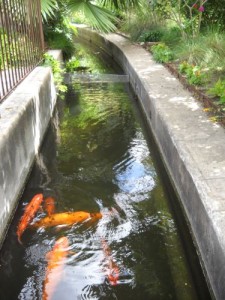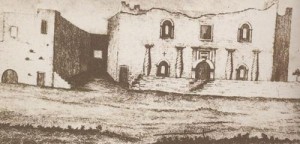Nearly everyone in the United States has some awareness of the Alamo, even if it’s just our fifth-grade teacher saying “something something ‘Remember the Alamo’ something something” in social studies. Or, “Hey! Isn’t that the movie with John Wayne?” There’s a lot of that going around.
The Alamo, more properly called “Mission de San Antonio de Valero,” was one of the five missions in San Antonio that were founded by Franciscan missionaries from Spain. The word “Alamo” means “cottonwood,” and no one is sure how the mission got this nickname.
The original Alamo mission was in or near what is now San Pedro Springs Park (writeup to follow later, but for now, the header image on this blog is from the park). The mission moved several times over the years before finally settling in its current location near the San Antonio River.
What we see as the Alamo today is by no means the entire mission. The mission started not too far behind the current buildings (which were the church and the convento, where the monks lived) and stretched out in front of the mission, across Alamo Street. As I write this, you can see the foundation of the original walls on the other side of Alamo Street. There are discussions of somehow rebuilding the complex, but with buildings that are also historic landmarks on the other side of the street, I find that impracticable.
You may find it odd that the Alamo grounds didn’t to all the way to the river. That is because the missionaries set up an alternative sort of water delivery system called “acequias.” The acequia system in San Antonio consisted of seven acequias, one for each mission, one for San Fernando de Bexar, the original village that eventually became San Antonio, and another that started out as a flood control measure in the late 19th century.

As an aside, if you know your Catholic saints, I am sure you notice that there is no St. Antonio of Valero or St. Ferdinand of Bexar. As I point out in my post on St. Augustine, Spaniards named places after the saint’s day that they were first sighted/visited/settled. San Antonio de Valero was founded on the day of St. Anthony of Padua. The “Valero” comes from the title of the Viceroy of New Spain at the time, Baltasar de Zúñiga y Guzmán, duque de Arión y marqués de Valero (title copied and pasted from the Wikipedia article, because I’ve got places to go today and didn’t have time to painstakingly transcribe all of that). I would assume that San Fernando de Bexar was founded on May 30, which is St. Fernando’s feast day, and took a different part of Baltasar’s title. Baltasar was the second son of the Duke of Béjar, Spain. The “j” turned into an “x” as a result of Mexican influence.
The Alamo was an active church until the Spaniards deconsecrated (which is different from desecration) it in 1793. Then when the Texians wanted their independence from Mexico, the famous battle was held at the site, which was pretty much a ruin by then, in March of 1836. All of the adult male Texians died during the battle, though some women and children survived. One of the primary sources that historians have traditionally used are the reminiscences of Enrique Esparza, who was present for the battle, though he was either six or eight years old at the time.
This is where the “Remember the Alamo” part comes in. The Battle of the Alamo was such a resounding defeat for the Texians that they went on to win the final battle of the Texas Revolution, the Battle of San Jacinto (“Jacinto” is pronounced, “ja-cin-toe,” not “ha-ceen-to”) in 18 minutes.
Over the intervening years, the locals scavenged the site for building stone, leaving just the church and part of the convento standing. Texas became a state of the United States on December 29, 1845, and the United States Army rented the church, such as it was, beginning in 1846 (my fingers keep wanting to type “19” instead of “18” for the years. This is probably a side-effect of typing birth years nearly all day at work).

San Antonio seceded from the Union along with the rest of Texas on February 1, 1861, so that was pretty much it for the presence of the United States Army at that point. They moved out, then back in after the Civil War. When Fort Sam Houston was founded in 1876, the Army left the Alamo for good.
The Alamo was used for other purposes for several decades, including as a general store. The Alamo now belongs to the State of Texas, which appointed the Daughters of the Republic of Texas as caretakers. In 2011, care of the Alamo was transferred from the Daughters of the Republic of Texas to the Texas General Land Office.
The Alamo has another, more odd, bit of history. Moving mature trees is a thing around here. I don’t think I’d ever heard of that before moving to Texas. At least in the area where I grew up, if you want a tree in a location, you plant a sapling and wait, but here in San Antonio there are actual companies that exist just to move trees. The first mature tree successfully transplanted in the area is in the courtyard of the Alamo. They estimate that the tree is around 140 years old and it has been in its current location since it was put there by Walter Whall in 1912.
As you probably know by now, I’m a Chicago girl, and when first found out that I was moving down here, a coworker told me that she had expected the Alamo to be out in the desert (probably thanks to our friend John Wayne), but that it was right downtown. My frame of reference for “downtown” is tall buildings and big business. I was picturing it somewhere like Daley Plaza in Chicago. I found the reality to be very different. The tall-ish buildings part of downtown is a good quarter-mile to half-mile away from the Alamo. The area where the Alamo sits is mostly hotels, actually. There’s the Menger (five stories), behind it is the Crockett (six stories), and to the north is the Emily Morgan Hotel (13 stories), so if you’re imagining a concrete canyon, don’t.
You will notice that I do not have any photographs of the inside of the Alamo. This is because the Alamo has a no-photography policy. There are photographs of the interior available online, if you want to go looking for them, but I have never felt comfortable trying to take pictures there myself. The Alamo is handicap accessible. I thought that the exit door had stairs, but after looking at photographs (of the outside), I see that I was mistaken.
